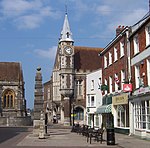Holy Trinity Church, Dorchester
Buildings and structures in Dorchester, DorsetChurch of England church buildings in DorsetChurches in DorsetFormer churches in DorsetGrade II listed churches in Dorset ... and 3 more
Infobox religious building with unknown affiliationRoman Catholic Diocese of PlymouthRoman Catholic churches in Dorset

Holy Trinity Church is a Roman Catholic and former Church of England church in Dorchester, Dorset, England. Built in 1875–76 to the designs of Benjamin Ferrey, it was declared redundant by the Church of England in 1975 and reopened the following year as a Roman Catholic church. It has been a Grade II listed building since 1975.
Excerpt from the Wikipedia article Holy Trinity Church, Dorchester (License: CC BY-SA 3.0, Authors, Images).Holy Trinity Church, Dorchester
High West Street,
Geographical coordinates (GPS) Address Nearby Places Show on map
Geographical coordinates (GPS)
| Latitude | Longitude |
|---|---|
| N 50.7155 ° | E -2.4379 ° |
Address
Holy Trinity Catholic Church
High West Street
DT1 1UJ
England, United Kingdom
Open on Google Maps










